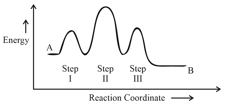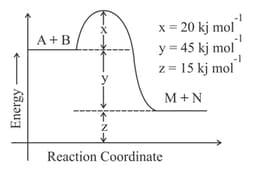HARD
Earn 100
Consider the following reaction that goes from to in three steps as shown below:

Choose the correct option
Number of
Intermediates
Number of
Activated
Complexes
Rate
determining
step

Intermediates
Activated
Complexes
determining
step
(a)
(b)
(c)
(d)
64.63% studentsanswered this correctly
Important Questions on Chemical Kinetics
EASY
HARD
EASY
EASY
HARD
It was found that the is decreased by in the presence of catalyst. If the rate remains unchanged, the activation energy for catalysed reaction is (Assume pre-exponential factor is same)
MEDIUM
i. Changes the of the reaction
ii. Decrease the activation energy for the forward and backward reaction equally
iii. Provides a new path of higher activation energy
iv. Increases the average kinetic energy of reacting molecules
HARD
EASY
MEDIUM
MEDIUM
EASY
EASY
EASY
MEDIUM
EASY
MEDIUM
in
is equal to __________ . (Integer answer)

EASY
HARD
For a reversible reaction, , which one of the following statement is wrong from the given energy profile diagram?

MEDIUM
Identify the incorrect statement.

EASY

